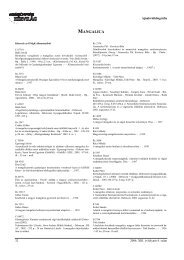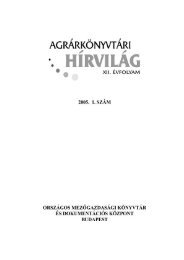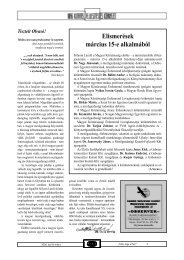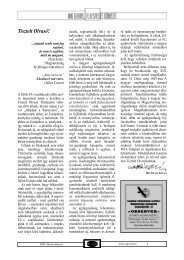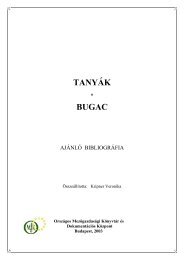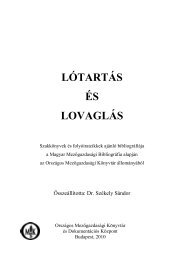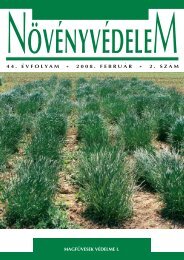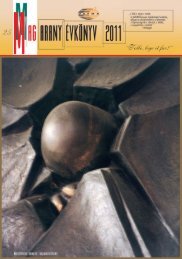hUNGARiAN AGRicUltURAl RESEARch
hUNGARiAN AGRicUltURAl RESEARch
hUNGARiAN AGRicUltURAl RESEARch
You also want an ePaper? Increase the reach of your titles
YUMPU automatically turns print PDFs into web optimized ePapers that Google loves.
Babo, T. 1 , L. Kocsis 2<br />
Babo Branch Cordon System as a new approach<br />
in modern viticulture<br />
Grapevine pruning – reasons and<br />
biological basis<br />
Grape existed on the Earth<br />
before human beings appeared.<br />
As far as we know viticulture<br />
developed together with humans.<br />
No one knows when pruning first<br />
started, but one of the reasons<br />
could be to get fruit close to the<br />
ground, thus making fruit<br />
collection easier for ancient<br />
mankind. Pruning controls yield<br />
in viticulture. 80–90% of cane<br />
produced by vine-stock is pruned<br />
during plant dormancy in winter.<br />
The result of such intervention is<br />
increase in yield, in length of<br />
aerial shoots, and decrease in<br />
number of clusters.<br />
As viticulture and science<br />
emerged our knowledge was<br />
extended regarding the effect of<br />
the pruning. Pongracz (1978)<br />
summarized the most important<br />
reasons for pruning (single small<br />
letters, like a., ) and the biological<br />
basis of pruning (double small<br />
letters like aa., ) as follows:<br />
a., To afford every young vine<br />
development above ground<br />
proportionate to its vigor and to<br />
the development of its root<br />
system.<br />
b., To provide new wood, i.e.<br />
one year-old canes, for bearers at<br />
the desired places.<br />
c., To regulate and ensure the<br />
production of grapes, as regards<br />
both quantity and quality, by<br />
leaving the correct number of fruit<br />
on the vine according to its<br />
capacity.<br />
d., To establish and maintain<br />
vines in a desired shape that will<br />
prevent damage during maintenance<br />
operation.<br />
e., To concentrate the activities<br />
of the vine into its permanent arms<br />
and bearing units.<br />
f., To remove worn-out and<br />
injured parts of old vines.<br />
aa., The fertile fruit of the vine<br />
occurred on the one – year-old –<br />
canes that arise from two-year-old<br />
wood.<br />
bb., On a cane the fertility of<br />
the fruit increases the farther they<br />
are removed from the base of the<br />
cane.<br />
cc., Excessively vigorous<br />
canes are not only less fruitful, but<br />
the fruitful grapes are farther up<br />
on the canes.<br />
dd., Canes with short<br />
internodes usually possess more<br />
fertile eyes than those with long<br />
internodes.<br />
ee., Only well-ripened canes<br />
that have borne well during the<br />
previous season should be used as<br />
bearers.<br />
ff., Every vine can properly<br />
nourish and ripen only a certain<br />
number of bunches and canes, and<br />
this is proportional to its vigor<br />
Hence every vine must be pruned<br />
on the basis of its own condition.”<br />
What is the Babo Branch Cordon<br />
System?<br />
The Babo Branch Cordon<br />
System (BBCS) more or less<br />
fulfills all the above mentioned<br />
requirements, however, slightly<br />
differently than we usually prune.<br />
The BBCS vine-stock shape is<br />
obtained by high-cordon cultivation.<br />
Cluster reduction is<br />
achieved by removing budding<br />
shoots and their gemmules within.<br />
This increases the number of<br />
branches produced, but reduces<br />
their lengths. Since fewer canes<br />
appear, pruning can be omitted.<br />
A greater portion of the plant’s<br />
energy is channeled to fruit and<br />
less to cane production. Depending<br />
on the cluster load of vinestock,<br />
the plant’s energy boosts<br />
the quality or quantity of yield.<br />
Let us see one by one how this<br />
training system fulfills the<br />
requirements of Pongracz’s<br />
sentences.<br />
a., The development of the<br />
young vine is similar to any other<br />
training systems. The young cane<br />
has to be cut back one or two buds<br />
and the trunk and the arm should<br />
be treated as the required form. In<br />
our case it should be let to grow<br />
up, as high the cordon arms will<br />
be about 180 cm high, and the<br />
length depends on the vine<br />
spacing; it could be 1m to 2.5 m<br />
according to the variety and soil<br />
conditions. The above ground<br />
parts and the root system will<br />
develop parallel.<br />
b., The new canes possible will<br />
develop where buds exists on the<br />
one year old cane, as the branches<br />
positioned vertically and the young<br />
shoots removed in a certain area of<br />
the canes the shoots will develop in<br />
certain places on the vine.<br />
1Private producer, Budapest<br />
2Pannon University, Georgikon Faculty, Department of Horticulture, H-8360 Keszthely, Deak F. u. 16, Hungary, kocsis-l@georgikon.hu<br />
Hungarian Agricultural Research 2009/3–4 21



